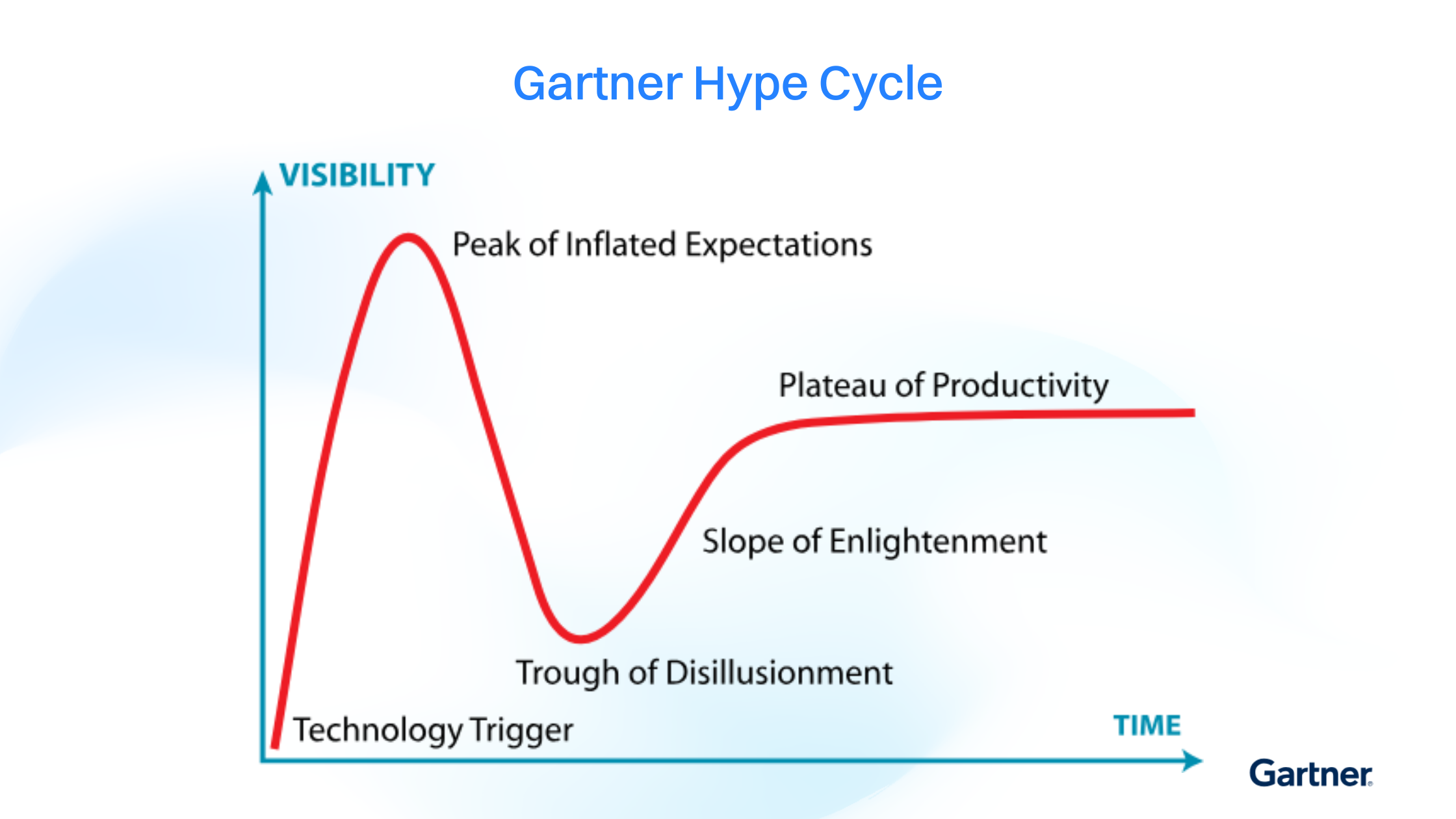Leaders across industries are talking about AI, but what about insurance? While insurance leaders tend to prefer a more grounded approach to adopting AI, they’re no less enthusiastic about its potential. Insurance quietly leads AI adoption compared to all other industries except for tech, media, and telecom. Though insurers can appreciate the hype, they’re focused on what matters most: building efficiency and accuracy without compromising compliance or trust.
Remember the Gartner Hype Cycle? The Hype Cycle is a graphic representation of the trajectory emerging technologies often take when they are introduced to the public. An emerging tech breakthrough begins with a burst of excitement, media interest, and publicity, even without usable products. Inflated expectations reach their peak after early publicity gives way to success, but interest eventually wanes when experiments stop taking off. Projects stall, enthusiasm wanes, and the most practical, lasting applications of the technology emerge. Eventually, the technology reaches equilibrium and becomes part of everyday operations.
When it comes to artificial intelligence (AI), we’re already seeing this story unfold. Customer facing tools like ChatGPT or image generation tools reached the public virtually overnight, driving up unprecedented adoption – and just as quickly, “AI fatigue.” In insurance, though, the cycle looks different, and AI is now less of a novelty and more of an operational must-have.
Across claims, early experiments in AI-powered document processing have evolved into mature, usable products for claims summarization, document automation, and intelligent decision support. Insurers are using AI to boost productivity in sales and hyperpersonalize customer service, automate claims, and transform back-office duties.
No longer hype-driven pilots, AI tools are real, deployed systems that deliver measurable results. And unlike some industries that hit a “trough of disillusionment,” the insurance sector’s emphasis on accuracy, compliance, and human oversight may help keep this momentum sustained.

Insurance Industry AI Fights the Hype
Some industries are “fast tracking” the hype cycle, and this is true for claims. AI is quickly becoming the single most important industry priority for insurance executives across economic, political, social, operational, technology, and business categories. In claims, the early “hype” of AI powered claims document processing gave way to usable products like claims summarization platforms and new use cases like document automation, decision support, and AI copilots.
While “AI fatigue” does exist across organizations, claims have not really seen the same “trough of disillusionment” faced by other industries. While this doesn’t mean it can’t happen, it might just be that insurers often choose to fight the hype: compliance standards, regulatory requirements, and legal risks mean insurance industry players might choose to inject more specialized, domain specific knowledge or human oversight into their models.
This added robustness can help to “skip” or compress some of the AI hype stages (like the trough of disillusionment) by injecting a layer of trust that mitigates the skepticism often seen when expectations outpace real-world results. Although “AI fatigue” has set in for some sectors, insurance leaders tend to focus on sustaining momentum and making a measurable, practical impact, especially in claims. This focus helps stabilize the process of AI adoption across the organization.
“Humans-in-the-Loop” Create Lasting Efficiency in Claims
Human in the loop models introduce critical human touchpoints into AI efforts. According to a study by IDC, 75% of companies face challenges with their data quality, which holds back their AI efforts. Human oversight, model governance, and compliance standards (like data security and auditability) can act as stabilizers that help insurance decision makers and claims teams feel comfortable with results and fight the hype. In a recent claims industry survey across claims professionals, just 16% of respondents expressed medium or high trust in AI generated outputs on their own due to concerns around accuracy, compliance, and integration.
In the same study, 78% of workers report organizational AI use in the broader population, compared to just 58% of claims professionals. Claims teams are generally slower to adopt new AI tools – but when they do, they take a measured, standards-driven approach to automation. Deployment is targeted, standards are maintained, and users remain optimistic. With this approach, every tool deployed delivers real ROI, and users have a sense of trust, purpose, and accuracy across the organization.
Insurance is, after all, one of the oldest industries in the world – and claims teams accept this innovation and change with plenty of maturity.


.png)


